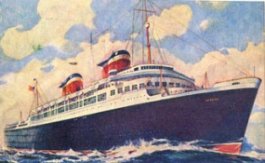 |
|
History of the America/West Point/Australis/American Star, Pt. 1 |
The birth of the America.
The "America" as she was first named, was designed by Messrs. Gibbs & Cox
of New York and built by the Newport News Shipbuilding & Dry Dock Company.
"While storm clouds gathered far across the sea..." -Irving Berlin's
introduction to "God Bless America" never rang truer than on 31st August,
1939. In Europe, German divisions massed along the Polish border. In the United
States, amid growing prosperity, a crowd of 30,000 gathered along the James River
at Newport News on a beautiful summers day to witness the first Lady of the land
christen the Nation's first lady of the seas. Mrs. Franklin D. Roosevelt did the
christening honours on the last day of August in that otherwise politically tense
summer of 1939. A day later, Hitler had ordered his forces to invade Poland. World
War II had started. America
left the yard for the first time under Captain Joseph Kemp and a shipyard crew
of 500 at 4:00a.m. on June 3rd., 1940, for her builder's trials off the Virginia
Capes, and returned 24 hours later. On the 9th, she sailed for drydocking at Boston
Navy Yard for cleaning and painting of her underwater hull, and arrived there
on the 11th. After standardization trials on the navy measured-mile course off
Rockland, Maine, were held on the 13th-14th, followed by an eight hour endurance
run on which she averaged 24.68 knots and reached 25.3 knots at 42,850 s.h.p.
the 33,500-Ton America, returned to Newport News for final fitting-out,
minor adjustments, and one major one.


At
the shipyard, America was to be converted into a Convoy Unit Loaded
Transport. In just eleven days, the same workmen who had fitted the luxurious
appointments just a year previously, replaced them with the dreary necessities
of a Naval Transport. Some of the work completed during those eleven days included
providing barracking, messing and sanitary facilities for an additional 5,400
persons, installing life rafts for the entire crew and troops, installing a
degaussing system, installing twelve anti-aircraft guns complete with ammunition
storage facilities and providing splinter protection and sky lookout stations.
The blackhull, white upper decks and red, white and blue funnels had been painted
with the familiar combination of blue-grey camouflage. On
15th, June 1941, the navy commissioned her the USS West Point. and placed
her under the control of the Naval Transport Service. The "America" was the
largest merchant ship built at this time-"The Queen of the luxury liners"-in
just 11 days she was stripped of her finery and converted into the U.S. Navy's
largest troop carrier.

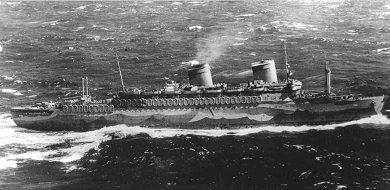

"The Grey Ghost"-USS
West Point.
After
five days working-up exercises off the Virginia Capes, West Point returned
to Norfolk on June 20th 1941, for additional refitting. 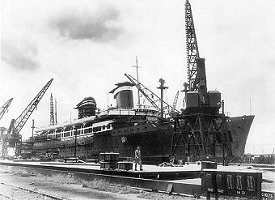 Appropriately,
her first assignment proved to be the ship's first Atlantic crossing. She embarked
137 Italian and 327 German consular officials off Staten Island on 16th July
and landed them at Lisbon on the 23rd. With 321 American and 67 Chinese consular
staff and their families, West Point sailed three days later for New
York and arrived on August 1st. To join the unprecedented American convoy WS-12
carrying British troops a month before Pearl Harbor, West Point sailed
from Portsmouth, Virginia, on November 3rd. 1941, to Halifax to embark 5,443
personnel of the British 55th. Brigade, 18th. Division and 100 U.S. Army personnel
for Basrah. Escorted by the Aircraft Carrier Ranger, cruisers Quincy
and Vincennes, and eight destroyers. America was at war by the time Cape
Town was reached on December 9th. Thence, West Point and Wakefield
proceeded directly to Bombay escorted by H.M.S. Dorsetshire and arrived
on the 27th.With
the rapidly deteriorating situation in Malaya, the British ordered both transports
to Singapore with their troops. After the 30-foot draft West Point jettisoned
some ballast, she and Wakefield, Duchess of Bedford, Empress of Japan
and Empire Star sailed on January 19, 1942. Escorted by H.M.S. Exeter
through Java's shallow Sundra Strait to avoid Japanes subs,
Appropriately,
her first assignment proved to be the ship's first Atlantic crossing. She embarked
137 Italian and 327 German consular officials off Staten Island on 16th July
and landed them at Lisbon on the 23rd. With 321 American and 67 Chinese consular
staff and their families, West Point sailed three days later for New
York and arrived on August 1st. To join the unprecedented American convoy WS-12
carrying British troops a month before Pearl Harbor, West Point sailed
from Portsmouth, Virginia, on November 3rd. 1941, to Halifax to embark 5,443
personnel of the British 55th. Brigade, 18th. Division and 100 U.S. Army personnel
for Basrah. Escorted by the Aircraft Carrier Ranger, cruisers Quincy
and Vincennes, and eight destroyers. America was at war by the time Cape
Town was reached on December 9th. Thence, West Point and Wakefield
proceeded directly to Bombay escorted by H.M.S. Dorsetshire and arrived
on the 27th.With
the rapidly deteriorating situation in Malaya, the British ordered both transports
to Singapore with their troops. After the 30-foot draft West Point jettisoned
some ballast, she and Wakefield, Duchess of Bedford, Empress of Japan
and Empire Star sailed on January 19, 1942. Escorted by H.M.S. Exeter
through Java's shallow Sundra Strait to avoid Japanes subs, 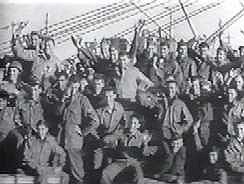 West
Point docked at Keppel Harbour, Singapore, with 5,272 troops and vital supplies
on the 29th. A Japanese air raid early the next morning hit Wakefield, straddled
West Point and showered her with shrapnel. The transport rendered medical
assistance to her fleetmate and both hastily completed their refuelling. After
taking on 1,946 military and civilian evacuees, West Point, together
with Wakefield, sailed at 6:00pm. on January 30th, 1942, and called at
Batavia the next day. In perhaps the "first" for a U.S. Navy vessel,
a baby boy was born aboard on February 4th. on the Equator, Christened Westpoint
Leslie Sheldrake, and the crew, "initiated the juvenile pollywog into a
heavenly shellback, certainly the youngest in the history of the navy"
West
Point docked at Keppel Harbour, Singapore, with 5,272 troops and vital supplies
on the 29th. A Japanese air raid early the next morning hit Wakefield, straddled
West Point and showered her with shrapnel. The transport rendered medical
assistance to her fleetmate and both hastily completed their refuelling. After
taking on 1,946 military and civilian evacuees, West Point, together
with Wakefield, sailed at 6:00pm. on January 30th, 1942, and called at
Batavia the next day. In perhaps the "first" for a U.S. Navy vessel,
a baby boy was born aboard on February 4th. on the Equator, Christened Westpoint
Leslie Sheldrake, and the crew, "initiated the juvenile pollywog into a
heavenly shellback, certainly the youngest in the history of the navy"
Now alone,
West Point sailed from Bombay on February 16th 1942, for Suez to Embark
5,333 men of the Australian 7th. division for Adelaide via Freemantle. On April
1st. she proceeded to Melbourne, Wellington and across the Pacific to arrive in
San Fransisco on the 24th With 5,526 GIs aboard, she returned "down under"
to Wellington on May 31st. From Melbourne on June 9th, the ship sailed for New
York via Panama and arrived July 2nd.
The West Point continued her worldwide trooping runs throughout 1943. She
sailed on February 15th. for Wellington and Melbourne with 7,961GIs. From Melbourne
on March 6th. she proceeded to Bombay and Suez. There, she embarked 2,167 POW's
of the defeated Afrika Corps and sailed to Massawa where 500 ANZAC troops boarded.
New orders were received to proceed without delay to New York. After dropping
her ANZACs at Aden on April 6th, she raced nonstop round the Cape and across the
South Atlantic to Rio De Janiero to reach New York on May 4th. after one of her
longest and fastest voyages. The
New Year 1944 found West Point continuing on the U.S.-Noumea-Milne Bay-Guadalcanal
"ferry". She left San Fransisco on January 11th for Noumea and Guadalcanal,
and from San Pedro on February 22nd. for 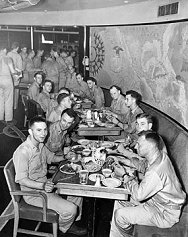 Noumea
and Milne Bay. Effective April 8th she was commanded by Captain Webb. C. Hayes,
USNR, the Grandson of President Rutherford B. Hayes. From San Fransisco West
Point set out on April 27th for Sydney and Milne Bay, but on the 30th. was
ordered to the East Coast after this voyage. She had carried a total of 47,000
troops to the South Pacific and returned with 11,000 wounded and other passengers.
Leaving Milne Bay's beautiful anchorage for the last time on May 20th 1944, West
Point steamed via Panama and docked at Boston on June 12th. Reassigned to
the european Theatre of Operations, West Point entered the most demanding
and valuable phase of her wartime career. Instead of the varied ports, often placid
days steaming at 18 knots beneath the Southern Cross and time for rest and refit
upon returning home, West Point and her men soon adapted themselves to
the rigors of the North Atlantic run-hard steaming through fog and filthy weather
on a zig-zag pattern at 22-24 knots with no escort and time between crossings
measured in hours. Now, her defense-oriented design proved invaluable. The huge
bunker capacity enabled her to steam at full speed across the Atlantic and back
without refuelling, keeping her U.K. turnaround time to 36 hours or less. Her
capability to steam full speed on just five boilers permitted rotating maintenance
underway on the sixth. Between June 27 1944 and June 24 1945, West Point
crossed the Atlantic 27 times and carried 140,000 passengers to British ports,
Oran, Casablanca, Marseilles and Le Havre. On her Boston-Liverpool crossing of
August 9-14, 1944, with part of the 95th Division she had 9,305 people aboard,
the most carried on a single U.S. vessel during the war. On westbound crossings
she carried wounded or POWs-on October 21st she arrived at Boston from Liverpool
with 4,346 prisoners. In a zero-zero fog, she cleared Liverpool on November 11th
at 15 knots using only radar bearings on the Mersey buoys to find her way out
to sea. As a well-deserved respite, West Point was re-assigned to the Mediterranean
for a few voyages, the first leaving
Noumea
and Milne Bay. Effective April 8th she was commanded by Captain Webb. C. Hayes,
USNR, the Grandson of President Rutherford B. Hayes. From San Fransisco West
Point set out on April 27th for Sydney and Milne Bay, but on the 30th. was
ordered to the East Coast after this voyage. She had carried a total of 47,000
troops to the South Pacific and returned with 11,000 wounded and other passengers.
Leaving Milne Bay's beautiful anchorage for the last time on May 20th 1944, West
Point steamed via Panama and docked at Boston on June 12th. Reassigned to
the european Theatre of Operations, West Point entered the most demanding
and valuable phase of her wartime career. Instead of the varied ports, often placid
days steaming at 18 knots beneath the Southern Cross and time for rest and refit
upon returning home, West Point and her men soon adapted themselves to
the rigors of the North Atlantic run-hard steaming through fog and filthy weather
on a zig-zag pattern at 22-24 knots with no escort and time between crossings
measured in hours. Now, her defense-oriented design proved invaluable. The huge
bunker capacity enabled her to steam at full speed across the Atlantic and back
without refuelling, keeping her U.K. turnaround time to 36 hours or less. Her
capability to steam full speed on just five boilers permitted rotating maintenance
underway on the sixth. Between June 27 1944 and June 24 1945, West Point
crossed the Atlantic 27 times and carried 140,000 passengers to British ports,
Oran, Casablanca, Marseilles and Le Havre. On her Boston-Liverpool crossing of
August 9-14, 1944, with part of the 95th Division she had 9,305 people aboard,
the most carried on a single U.S. vessel during the war. On westbound crossings
she carried wounded or POWs-on October 21st she arrived at Boston from Liverpool
with 4,346 prisoners. In a zero-zero fog, she cleared Liverpool on November 11th
at 15 knots using only radar bearings on the Mersey buoys to find her way out
to sea. As a well-deserved respite, West Point was re-assigned to the Mediterranean
for a few voyages, the first leaving 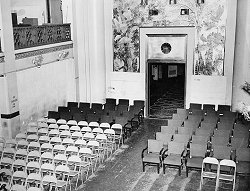 Boston
on December 6, 1944, for Marseilles and thence to Mers-el-Kebir. Her crew even
got to spend Christmas at home, returning to Newport News on the 19th. The new
year 1945 was only four days old when she got her new assignment: Newport News
to Naples with 7,741 men of the crack 10th Mountain Infantry Division destined
to drive out the Germans from their Alpine strongholds. A U-boat sank a British
tanker off the Straits of Gibraltar hours before West Point reached the
area. She returned to Boston with 6,470 passengers and then made two round voyages
to Gourock which proved to be her most arduous wartime trips.
Boston
on December 6, 1944, for Marseilles and thence to Mers-el-Kebir. Her crew even
got to spend Christmas at home, returning to Newport News on the 19th. The new
year 1945 was only four days old when she got her new assignment: Newport News
to Naples with 7,741 men of the crack 10th Mountain Infantry Division destined
to drive out the Germans from their Alpine strongholds. A U-boat sank a British
tanker off the Straits of Gibraltar hours before West Point reached the
area. She returned to Boston with 6,470 passengers and then made two round voyages
to Gourock which proved to be her most arduous wartime trips.
With
7,690 troops aboard, West Point left Boston on February 10, 1945, and
picked up her Royal Navy escort, H.M.S. Cavendish and H.M.S. Huron, six days
later for the passage through the Irish sea. At dusk the next day, 100 miles
from Clyde, a submarine was detected ten miles ahead and West Point went
immediately to General Quarters. Within minutes, one of the escorts dropped
a pattern of depth charges just 200 yards off the transport's starboard beam
while aircraft dropped markers. The West Point rang up to full revolutions
and pulled away from danger, leaving the destroyers to continue hunting the
U-boat. The passage home from Gourock to Boston February 20-27, 1945 was marked
by one of the most ferocious storms encountered in the vessel's history. One
day out of the Clyde with 1,325 passengers aboard, she ran into hurricane-force
winds and mountainous seas. Reports of U-boats nearby required the vessel to
maintain full speed. Suddenly and without warning, an enormous wave hit her
bow-on, engulfing the foc`sle with such force as to demolish the forward gun
plarform, sheer off stanchions and bend ladders. Although the gun crew had earlier
sought shelter, the remaining look-out was tragically killed on impact, West
Point's only casualty. Her storm-battered escorts, H.M.S. Cavendish and
H. M. S. Cambrian, were forced back to port. Battered and bruised, West Point
plowed her way across the Atlantic and reached Boston safely.
After
V-E Day, 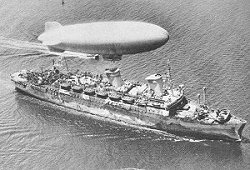 West
Point was assigned Operation Magic Carpet, returning American GIs and wounded
from Europe, effective with her June 24, 1945 sailing from Norfolk to Le Havre
where she arrived July 1st. The West Point received her second great New York
reception on the 11th when together with the Queen Mary she bought home a full
compliment of GIs to a heroes welcome. In brilliant weather, the returning troops
were greeted with aerial and sea escort, banners, flags and a din of whistles
and sirens. The West Point carried a huge sign on her Sun Deck reading "On
to Tokyo". Captain Hayes said it was a proud moment for "the greatest
transport in the world" and added "she can turn on a dime and is the
sweetest handling ship I ever saw" (New York Times). Among the 7,607 passengers
were 6,000 men of the 87th Division and 33 Japenese diplomats from Axis and
occupied countries to whom "Hundreds of GIs who lined the transport's rail
hurled candid Anglo-Saxon invectives" (New York Times) as they disembarked.
West
Point was assigned Operation Magic Carpet, returning American GIs and wounded
from Europe, effective with her June 24, 1945 sailing from Norfolk to Le Havre
where she arrived July 1st. The West Point received her second great New York
reception on the 11th when together with the Queen Mary she bought home a full
compliment of GIs to a heroes welcome. In brilliant weather, the returning troops
were greeted with aerial and sea escort, banners, flags and a din of whistles
and sirens. The West Point carried a huge sign on her Sun Deck reading "On
to Tokyo". Captain Hayes said it was a proud moment for "the greatest
transport in the world" and added "she can turn on a dime and is the
sweetest handling ship I ever saw" (New York Times). Among the 7,607 passengers
were 6,000 men of the 87th Division and 33 Japenese diplomats from Axis and
occupied countries to whom "Hundreds of GIs who lined the transport's rail
hurled candid Anglo-Saxon invectives" (New York Times) as they disembarked.
The
West Point was reassigned to the Pacific on December 5, 1945, and sailed
from Boston five days later for Manila via Pearl Harbour. With 7,737 aboard,
including the last 247 enlisted WACs in the Pacific, she left Manila on January
15, 1946, and docked at Pier 88, New York on February 7th. This ended her "hitch"
in the Navy and she proceeded to Portsmouth, Virginia, arriving on the 11th
and was released from duty on the 22nd. Her final voyage as West Point was a
short one: Seventeen miles to her birthplace of Newport News where she was decommissioned
on February 28th and officially stricken from the Navy Register on March 12th.
In all, West Point had accomplished 145 missions, made fifteen Pacific
crossings and 41 on the Atlantic, steamed 436,144 nautical miles and carried
505,020 passengers-American GIs, British Tommies, ANZACs, 4,000 WACs and WAVES,
16,000 wounded, civilians, diplomats, officials, USO stars(including Red Skelton,
Barbara Stanwyck and Heddy Lamarr), Red Cross workers, evacuees and 14,000 POWs.
On a normal trooping run, 20 tons of food were consumed daily and more bottles
of Coca Cola sold than in any single land establishment and, it was said, more
card and crap games played than on any other vessel! Exemplfying Navy "Can
Do" spirit, she largely operated without escort, experienced numerous close
calls, was reported sunk seven times by Axis Sally, never suffered a mechanical
breakdown and never failed to carry out an assignment. "The Grey Ghost"
had earned her place in Naval Annals and in the hearts of her officers, crew
and wartime passengers.
"America"
Reborn.
"Spick
and span, polished to her last porthole, the made-over America glided majestically
into her home port yesterday to prepare for her maiden voyage as 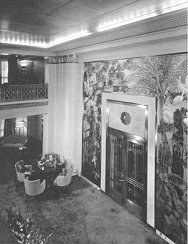 passenger
queen of our merchant fleet. None of the thousands who watched her pass... could
doubt that the great ship was a symbol of achievement in which the country can
take pride. She bears the right name" -New York Times, November 12th, 1946.
Glistening
in fresh paint, America left Newport News on November 9, 1946 to reclaim
her proud place as the nation's flagship to the salutes of the new aircraft carrier
Coral Sea and another Gibbs-designed ship, Santa Rosa. Aboard for the 770-mile
delivery and trials trip to New York were 483 invited guests and reporters, including
George Horne of the New York Times who enthused: "No ship in the world
is better built than this 26,459-ton liner. No ship can boast more passenger comfort
or surpass her in tasteful, beautiful decoration". True enough, W & J
Sloane Company had done a miraculous job recreating the original 1940 furnishings.
And America performed brilliantly as Commodore Harry Manning put her through
her paces with sharp turns, zig-zags and sustained speeds up to 24.3 knots: "She
has been tried and tested in the war, and she is better than ever" he was
later quoted. Exciting
war service and glamorous maiden arrivals behind her, America settled down
to the routine yet rigorous role of an Atlantic intermediate. The late `40s and
`50s were good times for a young, proud and efficient liner like her. Unfortunately,
like Leviathan she replaced, America proved to be a "lone wolf"
with the former Manhattan permanently converted to a troopship and Washington
never fully restored. Annually, America made 15-18 round trip voyages,
a demanding schedule that kept her on the North Atlantic year-round.
"She
had some very attractive public rooms, such as her double-deck lounge and her
main Ballroom. She also had some very nice Staterooms, many of which were so much
larger than some of the rather cramped quarters offered in today's mega-cruiseships".
C. M. Squarey, the noted British connoisseur of passenger ships, cast his expert
eye over the America for the first time in March 1950. In his extensive journals
he wrote: "most people board a ship with certain expectations in mind. I expected
this ship would conform to what I might call the American pattern; in my view,
however, to call her a typical American ship would be wrong, yet there is quite
enough about her to remind you that she is, at heart, a 'Yankee' ship-and that,
indeed, is how she would be. Two women were entirely responsible for her furnishing.
I pay this liner the compliment, by my code, of saying that she is not glamorous;
rather she has the greatest asset of irresistible attraction based on sophisticated
charm. She blends very nicely restraint with progress; she incorporates a modern
approach to problems with just the right touch of respect for the old school."
passenger
queen of our merchant fleet. None of the thousands who watched her pass... could
doubt that the great ship was a symbol of achievement in which the country can
take pride. She bears the right name" -New York Times, November 12th, 1946.
Glistening
in fresh paint, America left Newport News on November 9, 1946 to reclaim
her proud place as the nation's flagship to the salutes of the new aircraft carrier
Coral Sea and another Gibbs-designed ship, Santa Rosa. Aboard for the 770-mile
delivery and trials trip to New York were 483 invited guests and reporters, including
George Horne of the New York Times who enthused: "No ship in the world
is better built than this 26,459-ton liner. No ship can boast more passenger comfort
or surpass her in tasteful, beautiful decoration". True enough, W & J
Sloane Company had done a miraculous job recreating the original 1940 furnishings.
And America performed brilliantly as Commodore Harry Manning put her through
her paces with sharp turns, zig-zags and sustained speeds up to 24.3 knots: "She
has been tried and tested in the war, and she is better than ever" he was
later quoted. Exciting
war service and glamorous maiden arrivals behind her, America settled down
to the routine yet rigorous role of an Atlantic intermediate. The late `40s and
`50s were good times for a young, proud and efficient liner like her. Unfortunately,
like Leviathan she replaced, America proved to be a "lone wolf"
with the former Manhattan permanently converted to a troopship and Washington
never fully restored. Annually, America made 15-18 round trip voyages,
a demanding schedule that kept her on the North Atlantic year-round.
"She
had some very attractive public rooms, such as her double-deck lounge and her
main Ballroom. She also had some very nice Staterooms, many of which were so much
larger than some of the rather cramped quarters offered in today's mega-cruiseships".
C. M. Squarey, the noted British connoisseur of passenger ships, cast his expert
eye over the America for the first time in March 1950. In his extensive journals
he wrote: "most people board a ship with certain expectations in mind. I expected
this ship would conform to what I might call the American pattern; in my view,
however, to call her a typical American ship would be wrong, yet there is quite
enough about her to remind you that she is, at heart, a 'Yankee' ship-and that,
indeed, is how she would be. Two women were entirely responsible for her furnishing.
I pay this liner the compliment, by my code, of saying that she is not glamorous;
rather she has the greatest asset of irresistible attraction based on sophisticated
charm. She blends very nicely restraint with progress; she incorporates a modern
approach to problems with just the right touch of respect for the old school."


After
the spectacular arrival of the United States in July 1952, and with her
instant and enormous popularity ("Everyone wanted to sail on her, especially
in those days" recalled noted historian Frank O. Braynard), the smaller, America
managed to hold her own for some years, but like most big Atlantic liners, the
America was affected in the late 1950's, by the sudden and very dramatic
appearance of the first commercial jets. First, her winter crossings were hit,
there being less and less passengers. United States Lines management wanted
to resume winter crossings to the Caribbean, her first in nearly a decade and
certainly the ideal economic alternative. Unfortunately, the US Government in
the form of the all-powerful Maritime Administration, which controlled the vital
subsidies given not only to America, but to the United States
as well, refused to permit cruising. Such tropic trips, so those Washington
Bureaucrats insisted, were in violation of the subsidy rules. American passenger
ships could not deviate from their prescribed services. It seemed that such
rules were carved in stone. Finally, in 1961, the Maritime Administration relented
and altered the rules. The America would be allowed to make her first
off-season cruise. It was a five-day trip over the long thanksgiving holiday
weekend in November. Minimum fares started at $145. More cruises followed and,
soon after, for the 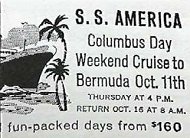 United
States as well, but the general picture was not very bright. Operating costs
were steadily rising-and at an alarming rate-and this against diminishing profits.
It was all complicated further by increasingly frequent strikes and labour problems.
The biggest blow, and perhaps the most significant turning point, not only for
the America, but for the United States as well, occurred in September
1963 just before a noon sailing for Europe, when a nasty labour problem erupted
onboard. This six-month-long catharsis began when a member of the crew (among
the 550 non-licensed staff belonging to the National Maritime Union) filed a
complaint against First assistant Engineer Louis Neurohr charging racial bias
against Negroes and Hispanics who made up 45 per cent of the crew. Some of the
crew suddenly refused to sail unless it was properly resolved. On behalf of
the complaint, the NMU asked U.S. Lines to remove Mr. Neurohr. in turn, Mr.
Neurohr's union, the Marine Engineers Beneficial Association(a longtime rival
of the NMU) sprang to his defence. The 550 NMU crew walked off the ship two
hours before sailing. U. S. Lines eventually cancelled the departure and later
that of October 4th. The line offered to re-assign Mr. Neurohr to one of its
freighters if the Union cleared him of the charges.
United
States as well, but the general picture was not very bright. Operating costs
were steadily rising-and at an alarming rate-and this against diminishing profits.
It was all complicated further by increasingly frequent strikes and labour problems.
The biggest blow, and perhaps the most significant turning point, not only for
the America, but for the United States as well, occurred in September
1963 just before a noon sailing for Europe, when a nasty labour problem erupted
onboard. This six-month-long catharsis began when a member of the crew (among
the 550 non-licensed staff belonging to the National Maritime Union) filed a
complaint against First assistant Engineer Louis Neurohr charging racial bias
against Negroes and Hispanics who made up 45 per cent of the crew. Some of the
crew suddenly refused to sail unless it was properly resolved. On behalf of
the complaint, the NMU asked U.S. Lines to remove Mr. Neurohr. in turn, Mr.
Neurohr's union, the Marine Engineers Beneficial Association(a longtime rival
of the NMU) sprang to his defence. The 550 NMU crew walked off the ship two
hours before sailing. U. S. Lines eventually cancelled the departure and later
that of October 4th. The line offered to re-assign Mr. Neurohr to one of its
freighters if the Union cleared him of the charges.
A
settlement was finally reached on September 19, 1963. The NMU agreed to man
the vessel and Mr. Neurohr was cleared of the charges and stayed at his post.
A happy Alexander Purdon, U. S. Lines Executive Vice-President, announced America
would return to service on February 7th, 1964, and called her " a great
old lady". The America left Hoboken under tow on January 22nd. to
Pier 86 for fuel and ballast before sailing the next day with a skeleton crew
of 250 for Newport News and a seven-day overhaul. In a classic encounter on
February 1st, the liner America passed the aircraft carrier America due
to be launched the next day. It was like old times as  America
sailed from New York on February 7th, 1964, with 772 passengers, including
Queen Frederika of Greece, and typically, amidst another strike; this time by
tugboats, but Captain Fender pulled America out smartly from Pier 86
unaided at 12:40p.m. despite 25mph wind gusts. "It's been a long, frustrating
vacation. I am certainly glad to be back at sea after such a long lay up"
he said. In 1964 America completed twelve round voyages and two cruises:
a ten-day trip on February 28th to St. Thomas, San Juan and Nassau and an eight-day
Bermuda voyage on March 11th.
America
sailed from New York on February 7th, 1964, with 772 passengers, including
Queen Frederika of Greece, and typically, amidst another strike; this time by
tugboats, but Captain Fender pulled America out smartly from Pier 86
unaided at 12:40p.m. despite 25mph wind gusts. "It's been a long, frustrating
vacation. I am certainly glad to be back at sea after such a long lay up"
he said. In 1964 America completed twelve round voyages and two cruises:
a ten-day trip on February 28th to St. Thomas, San Juan and Nassau and an eight-day
Bermuda voyage on March 11th.
America
never
really recovered from her long lay-up and if stories about a sale to Greek interests
were "utter nonesense" in 1963, they assumed considerably more credibility
a year later. Even with operational subsidies, America was no longer
a paying proposition for the owners or the Government. Her potential sale was
first reported by the Herald-Tribune on 13th August 1964, which said U.S. Lines
was "non-committal" on plans for the ship past December 31st when
her subsidy waiver expired, and a further extension was not requested.
It
was not until November 4th, 1964, that United States Lines formerly requested
Maritime Administration permission to cancel it's subsidy for America and
sell her to Okeania S.A., a subsidary of Chandris, for use as a passenger and
emigrant vessel. U.S. Lines cited "substantial net losses for several years"
and that "no prospects exist for improving such results" Maritime
approval came the next day, when it was revealed she had been sold for $4,250,000
with the understanding she not compete with U.S. flag liners from American ports
for five years and be made available for war emergency use under the U.S. flag
or that of Greece as part of Nato. After workmen removed her bridge nameboards
(one of which is now at the Mariners Museum), painted out all but the "A"
of her name on the bows and lowered the stars and stripes, America was
handed over to Okeania S.A. on November 16th, 1964. The nautical colours of
her funnels disappeared under a coat of Chandris blue and black. Two days later,
under a new name and foreign flag, the former S.S. America left Newport
News forever with only union pickets and a few other people there to bid her
farewell, two hours after U.S.S. America left the yards for the first time amid
celebration.
|
During
her almost a quarter of a century under the Stars and Stripes, S.S. America\U.S.S.
West Point posted a record of service and success that surpassed strikes
and subsidy squabbles. She had steamed 2,800,000 miles, completed 288
Atlantic voyages while carrying 476,462 passengers, some 20,000 more on
cruises and 505,020 in wartime. Whether dodging Japenese bombs or German
torpedoes, plowing through winter North Atlantic seas or serenely cruising
the troops, America always did her name and nation proud.
|
Click the arrow below to read the History of the America/West Point/Australis/American Star, Pt. 2:
Welcome all visitors to the S.S. Australis Website, which has now been online since 1998!
I will continue to update the site if I receive a new story, or if you have interesting photos taken on the ship during your voyage
on either the southbound, northbound, or on one of the South Pacific cruises. We used to do those trips several times a year
from Melbourne, Sydney and Auckland (New Zealand).
I am deeply moved by the interest and wonderful contributions from the numerous passengers and crew over many years.
You can send an e-mail to me on the link below: 
A HUGE THANK YOU
Warm Regards
Ken
|


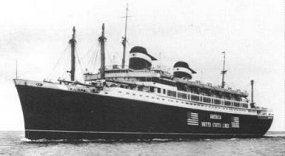
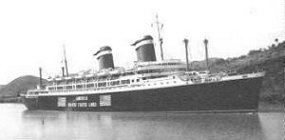

 Appropriately,
her first assignment proved to be the ship's first Atlantic crossing. She embarked
137 Italian and 327 German consular officials off Staten Island on 16th July
and landed them at Lisbon on the 23rd. With 321 American and 67 Chinese consular
staff and their families, West Point sailed three days later for New
York and arrived on August 1st. To join the unprecedented American convoy WS-12
carrying British troops a month before Pearl Harbor, West Point sailed
from Portsmouth, Virginia, on November 3rd. 1941, to Halifax to embark 5,443
personnel of the British 55th. Brigade, 18th. Division and 100 U.S. Army personnel
for Basrah. Escorted by the Aircraft Carrier Ranger, cruisers Quincy
and Vincennes, and eight destroyers. America was at war by the time Cape
Town was reached on December 9th. Thence, West Point and Wakefield
proceeded directly to Bombay escorted by H.M.S. Dorsetshire and arrived
on the 27th.With
the rapidly deteriorating situation in Malaya, the British ordered both transports
to Singapore with their troops. After the 30-foot draft West Point jettisoned
some ballast, she and Wakefield, Duchess of Bedford, Empress of Japan
and Empire Star sailed on January 19, 1942. Escorted by H.M.S. Exeter
through Java's shallow Sundra Strait to avoid Japanes subs,
Appropriately,
her first assignment proved to be the ship's first Atlantic crossing. She embarked
137 Italian and 327 German consular officials off Staten Island on 16th July
and landed them at Lisbon on the 23rd. With 321 American and 67 Chinese consular
staff and their families, West Point sailed three days later for New
York and arrived on August 1st. To join the unprecedented American convoy WS-12
carrying British troops a month before Pearl Harbor, West Point sailed
from Portsmouth, Virginia, on November 3rd. 1941, to Halifax to embark 5,443
personnel of the British 55th. Brigade, 18th. Division and 100 U.S. Army personnel
for Basrah. Escorted by the Aircraft Carrier Ranger, cruisers Quincy
and Vincennes, and eight destroyers. America was at war by the time Cape
Town was reached on December 9th. Thence, West Point and Wakefield
proceeded directly to Bombay escorted by H.M.S. Dorsetshire and arrived
on the 27th.With
the rapidly deteriorating situation in Malaya, the British ordered both transports
to Singapore with their troops. After the 30-foot draft West Point jettisoned
some ballast, she and Wakefield, Duchess of Bedford, Empress of Japan
and Empire Star sailed on January 19, 1942. Escorted by H.M.S. Exeter
through Java's shallow Sundra Strait to avoid Japanes subs,  West
Point docked at Keppel Harbour, Singapore, with 5,272 troops and vital supplies
on the 29th. A Japanese air raid early the next morning hit Wakefield, straddled
West Point and showered her with shrapnel. The transport rendered medical
assistance to her fleetmate and both hastily completed their refuelling. After
taking on 1,946 military and civilian evacuees, West Point, together
with Wakefield, sailed at 6:00pm. on January 30th, 1942, and called at
Batavia the next day. In perhaps the "first" for a U.S. Navy vessel,
a baby boy was born aboard on February 4th. on the Equator, Christened Westpoint
Leslie Sheldrake, and the crew, "initiated the juvenile pollywog into a
heavenly shellback, certainly the youngest in the history of the navy"
West
Point docked at Keppel Harbour, Singapore, with 5,272 troops and vital supplies
on the 29th. A Japanese air raid early the next morning hit Wakefield, straddled
West Point and showered her with shrapnel. The transport rendered medical
assistance to her fleetmate and both hastily completed their refuelling. After
taking on 1,946 military and civilian evacuees, West Point, together
with Wakefield, sailed at 6:00pm. on January 30th, 1942, and called at
Batavia the next day. In perhaps the "first" for a U.S. Navy vessel,
a baby boy was born aboard on February 4th. on the Equator, Christened Westpoint
Leslie Sheldrake, and the crew, "initiated the juvenile pollywog into a
heavenly shellback, certainly the youngest in the history of the navy" Noumea
and Milne Bay. Effective April 8th she was commanded by Captain Webb. C. Hayes,
USNR, the Grandson of President Rutherford B. Hayes. From San Fransisco West
Point set out on April 27th for Sydney and Milne Bay, but on the 30th. was
ordered to the East Coast after this voyage. She had carried a total of 47,000
troops to the South Pacific and returned with 11,000 wounded and other passengers.
Leaving Milne Bay's beautiful anchorage for the last time on May 20th 1944, West
Point steamed via Panama and docked at Boston on June 12th. Reassigned to
the european Theatre of Operations, West Point entered the most demanding
and valuable phase of her wartime career. Instead of the varied ports, often placid
days steaming at 18 knots beneath the Southern Cross and time for rest and refit
upon returning home, West Point and her men soon adapted themselves to
the rigors of the North Atlantic run-hard steaming through fog and filthy weather
on a zig-zag pattern at 22-24 knots with no escort and time between crossings
measured in hours. Now, her defense-oriented design proved invaluable. The huge
bunker capacity enabled her to steam at full speed across the Atlantic and back
without refuelling, keeping her U.K. turnaround time to 36 hours or less. Her
capability to steam full speed on just five boilers permitted rotating maintenance
underway on the sixth. Between June 27 1944 and June 24 1945, West Point
crossed the Atlantic 27 times and carried 140,000 passengers to British ports,
Oran, Casablanca, Marseilles and Le Havre. On her Boston-Liverpool crossing of
August 9-14, 1944, with part of the 95th Division she had 9,305 people aboard,
the most carried on a single U.S. vessel during the war. On westbound crossings
she carried wounded or POWs-on October 21st she arrived at Boston from Liverpool
with 4,346 prisoners. In a zero-zero fog, she cleared Liverpool on November 11th
at 15 knots using only radar bearings on the Mersey buoys to find her way out
to sea. As a well-deserved respite, West Point was re-assigned to the Mediterranean
for a few voyages, the first leaving
Noumea
and Milne Bay. Effective April 8th she was commanded by Captain Webb. C. Hayes,
USNR, the Grandson of President Rutherford B. Hayes. From San Fransisco West
Point set out on April 27th for Sydney and Milne Bay, but on the 30th. was
ordered to the East Coast after this voyage. She had carried a total of 47,000
troops to the South Pacific and returned with 11,000 wounded and other passengers.
Leaving Milne Bay's beautiful anchorage for the last time on May 20th 1944, West
Point steamed via Panama and docked at Boston on June 12th. Reassigned to
the european Theatre of Operations, West Point entered the most demanding
and valuable phase of her wartime career. Instead of the varied ports, often placid
days steaming at 18 knots beneath the Southern Cross and time for rest and refit
upon returning home, West Point and her men soon adapted themselves to
the rigors of the North Atlantic run-hard steaming through fog and filthy weather
on a zig-zag pattern at 22-24 knots with no escort and time between crossings
measured in hours. Now, her defense-oriented design proved invaluable. The huge
bunker capacity enabled her to steam at full speed across the Atlantic and back
without refuelling, keeping her U.K. turnaround time to 36 hours or less. Her
capability to steam full speed on just five boilers permitted rotating maintenance
underway on the sixth. Between June 27 1944 and June 24 1945, West Point
crossed the Atlantic 27 times and carried 140,000 passengers to British ports,
Oran, Casablanca, Marseilles and Le Havre. On her Boston-Liverpool crossing of
August 9-14, 1944, with part of the 95th Division she had 9,305 people aboard,
the most carried on a single U.S. vessel during the war. On westbound crossings
she carried wounded or POWs-on October 21st she arrived at Boston from Liverpool
with 4,346 prisoners. In a zero-zero fog, she cleared Liverpool on November 11th
at 15 knots using only radar bearings on the Mersey buoys to find her way out
to sea. As a well-deserved respite, West Point was re-assigned to the Mediterranean
for a few voyages, the first leaving  Boston
on December 6, 1944, for Marseilles and thence to Mers-el-Kebir. Her crew even
got to spend Christmas at home, returning to Newport News on the 19th. The new
year 1945 was only four days old when she got her new assignment: Newport News
to Naples with 7,741 men of the crack 10th Mountain Infantry Division destined
to drive out the Germans from their Alpine strongholds. A U-boat sank a British
tanker off the Straits of Gibraltar hours before West Point reached the
area. She returned to Boston with 6,470 passengers and then made two round voyages
to Gourock which proved to be her most arduous wartime trips.
Boston
on December 6, 1944, for Marseilles and thence to Mers-el-Kebir. Her crew even
got to spend Christmas at home, returning to Newport News on the 19th. The new
year 1945 was only four days old when she got her new assignment: Newport News
to Naples with 7,741 men of the crack 10th Mountain Infantry Division destined
to drive out the Germans from their Alpine strongholds. A U-boat sank a British
tanker off the Straits of Gibraltar hours before West Point reached the
area. She returned to Boston with 6,470 passengers and then made two round voyages
to Gourock which proved to be her most arduous wartime trips.
 West
Point was assigned Operation Magic Carpet, returning American GIs and wounded
from Europe, effective with her June 24, 1945 sailing from Norfolk to Le Havre
where she arrived July 1st. The West Point received her second great New York
reception on the 11th when together with the Queen Mary she bought home a full
compliment of GIs to a heroes welcome. In brilliant weather, the returning troops
were greeted with aerial and sea escort, banners, flags and a din of whistles
and sirens. The West Point carried a huge sign on her Sun Deck reading "On
to Tokyo". Captain Hayes said it was a proud moment for "the greatest
transport in the world" and added "she can turn on a dime and is the
sweetest handling ship I ever saw" (New York Times). Among the 7,607 passengers
were 6,000 men of the 87th Division and 33 Japenese diplomats from Axis and
occupied countries to whom "Hundreds of GIs who lined the transport's rail
hurled candid Anglo-Saxon invectives" (New York Times) as they disembarked.
West
Point was assigned Operation Magic Carpet, returning American GIs and wounded
from Europe, effective with her June 24, 1945 sailing from Norfolk to Le Havre
where she arrived July 1st. The West Point received her second great New York
reception on the 11th when together with the Queen Mary she bought home a full
compliment of GIs to a heroes welcome. In brilliant weather, the returning troops
were greeted with aerial and sea escort, banners, flags and a din of whistles
and sirens. The West Point carried a huge sign on her Sun Deck reading "On
to Tokyo". Captain Hayes said it was a proud moment for "the greatest
transport in the world" and added "she can turn on a dime and is the
sweetest handling ship I ever saw" (New York Times). Among the 7,607 passengers
were 6,000 men of the 87th Division and 33 Japenese diplomats from Axis and
occupied countries to whom "Hundreds of GIs who lined the transport's rail
hurled candid Anglo-Saxon invectives" (New York Times) as they disembarked. passenger
queen of our merchant fleet. None of the thousands who watched her pass... could
doubt that the great ship was a symbol of achievement in which the country can
take pride. She bears the right name" -New York Times, November 12th, 1946.
Glistening
in fresh paint, America left Newport News on November 9, 1946 to reclaim
her proud place as the nation's flagship to the salutes of the new aircraft carrier
Coral Sea and another Gibbs-designed ship, Santa Rosa. Aboard for the 770-mile
delivery and trials trip to New York were 483 invited guests and reporters, including
George Horne of the New York Times who enthused: "No ship in the world
is better built than this 26,459-ton liner. No ship can boast more passenger comfort
or surpass her in tasteful, beautiful decoration". True enough, W & J
Sloane Company had done a miraculous job recreating the original 1940 furnishings.
And America performed brilliantly as Commodore Harry Manning put her through
her paces with sharp turns, zig-zags and sustained speeds up to 24.3 knots: "She
has been tried and tested in the war, and she is better than ever" he was
later quoted. Exciting
war service and glamorous maiden arrivals behind her, America settled down
to the routine yet rigorous role of an Atlantic intermediate. The late `40s and
`50s were good times for a young, proud and efficient liner like her. Unfortunately,
like Leviathan she replaced, America proved to be a "lone wolf"
with the former Manhattan permanently converted to a troopship and Washington
never fully restored. Annually, America made 15-18 round trip voyages,
a demanding schedule that kept her on the North Atlantic year-round.
passenger
queen of our merchant fleet. None of the thousands who watched her pass... could
doubt that the great ship was a symbol of achievement in which the country can
take pride. She bears the right name" -New York Times, November 12th, 1946.
Glistening
in fresh paint, America left Newport News on November 9, 1946 to reclaim
her proud place as the nation's flagship to the salutes of the new aircraft carrier
Coral Sea and another Gibbs-designed ship, Santa Rosa. Aboard for the 770-mile
delivery and trials trip to New York were 483 invited guests and reporters, including
George Horne of the New York Times who enthused: "No ship in the world
is better built than this 26,459-ton liner. No ship can boast more passenger comfort
or surpass her in tasteful, beautiful decoration". True enough, W & J
Sloane Company had done a miraculous job recreating the original 1940 furnishings.
And America performed brilliantly as Commodore Harry Manning put her through
her paces with sharp turns, zig-zags and sustained speeds up to 24.3 knots: "She
has been tried and tested in the war, and she is better than ever" he was
later quoted. Exciting
war service and glamorous maiden arrivals behind her, America settled down
to the routine yet rigorous role of an Atlantic intermediate. The late `40s and
`50s were good times for a young, proud and efficient liner like her. Unfortunately,
like Leviathan she replaced, America proved to be a "lone wolf"
with the former Manhattan permanently converted to a troopship and Washington
never fully restored. Annually, America made 15-18 round trip voyages,
a demanding schedule that kept her on the North Atlantic year-round.
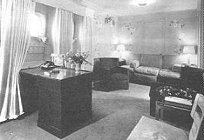
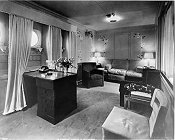
 United
States as well, but the general picture was not very bright. Operating costs
were steadily rising-and at an alarming rate-and this against diminishing profits.
It was all complicated further by increasingly frequent strikes and labour problems.
The biggest blow, and perhaps the most significant turning point, not only for
the America, but for the United States as well, occurred in September
1963 just before a noon sailing for Europe, when a nasty labour problem erupted
onboard. This six-month-long catharsis began when a member of the crew (among
the 550 non-licensed staff belonging to the National Maritime Union) filed a
complaint against First assistant Engineer Louis Neurohr charging racial bias
against Negroes and Hispanics who made up 45 per cent of the crew. Some of the
crew suddenly refused to sail unless it was properly resolved. On behalf of
the complaint, the NMU asked U.S. Lines to remove Mr. Neurohr. in turn, Mr.
Neurohr's union, the Marine Engineers Beneficial Association(a longtime rival
of the NMU) sprang to his defence. The 550 NMU crew walked off the ship two
hours before sailing. U. S. Lines eventually cancelled the departure and later
that of October 4th. The line offered to re-assign Mr. Neurohr to one of its
freighters if the Union cleared him of the charges.
United
States as well, but the general picture was not very bright. Operating costs
were steadily rising-and at an alarming rate-and this against diminishing profits.
It was all complicated further by increasingly frequent strikes and labour problems.
The biggest blow, and perhaps the most significant turning point, not only for
the America, but for the United States as well, occurred in September
1963 just before a noon sailing for Europe, when a nasty labour problem erupted
onboard. This six-month-long catharsis began when a member of the crew (among
the 550 non-licensed staff belonging to the National Maritime Union) filed a
complaint against First assistant Engineer Louis Neurohr charging racial bias
against Negroes and Hispanics who made up 45 per cent of the crew. Some of the
crew suddenly refused to sail unless it was properly resolved. On behalf of
the complaint, the NMU asked U.S. Lines to remove Mr. Neurohr. in turn, Mr.
Neurohr's union, the Marine Engineers Beneficial Association(a longtime rival
of the NMU) sprang to his defence. The 550 NMU crew walked off the ship two
hours before sailing. U. S. Lines eventually cancelled the departure and later
that of October 4th. The line offered to re-assign Mr. Neurohr to one of its
freighters if the Union cleared him of the charges.